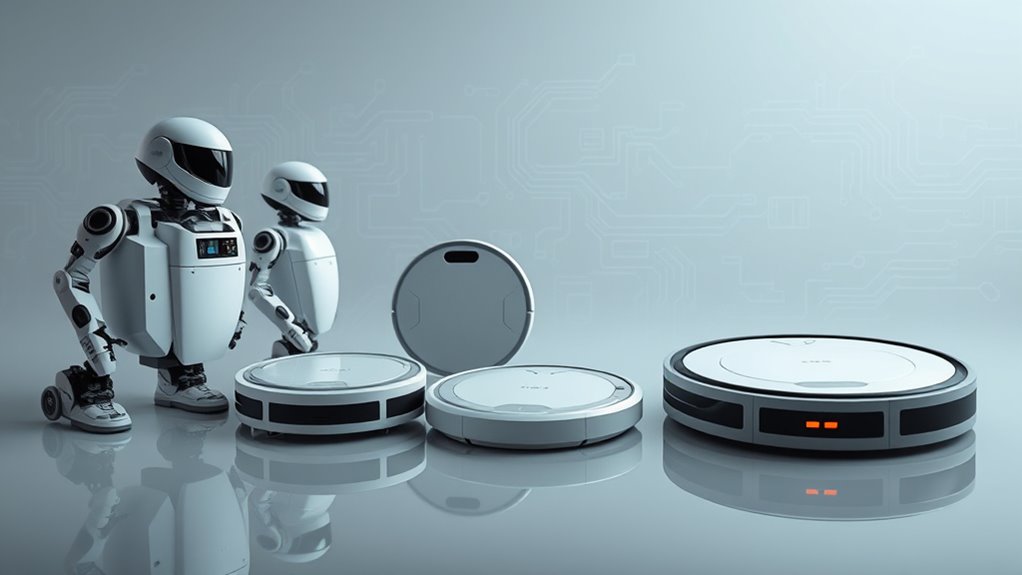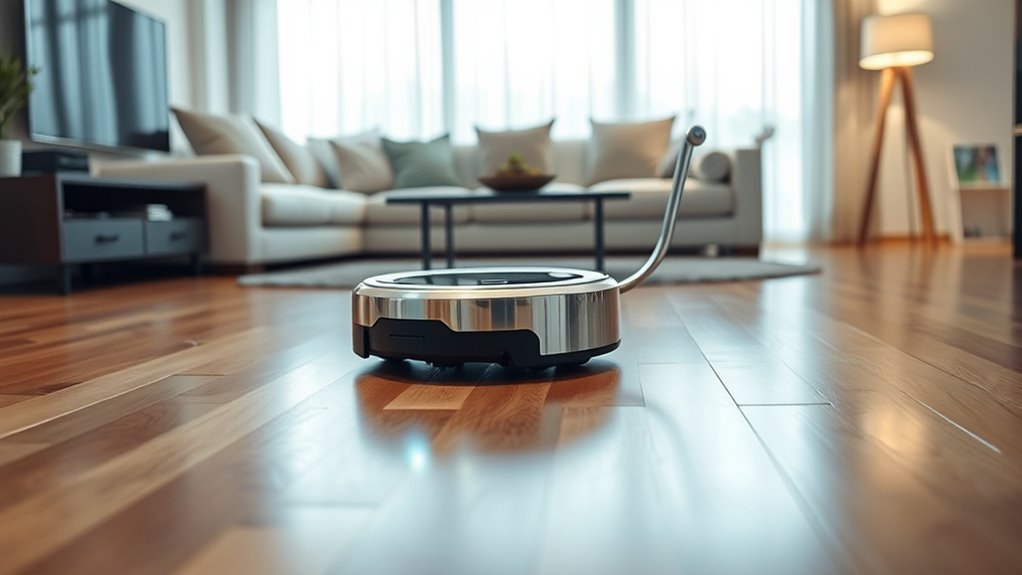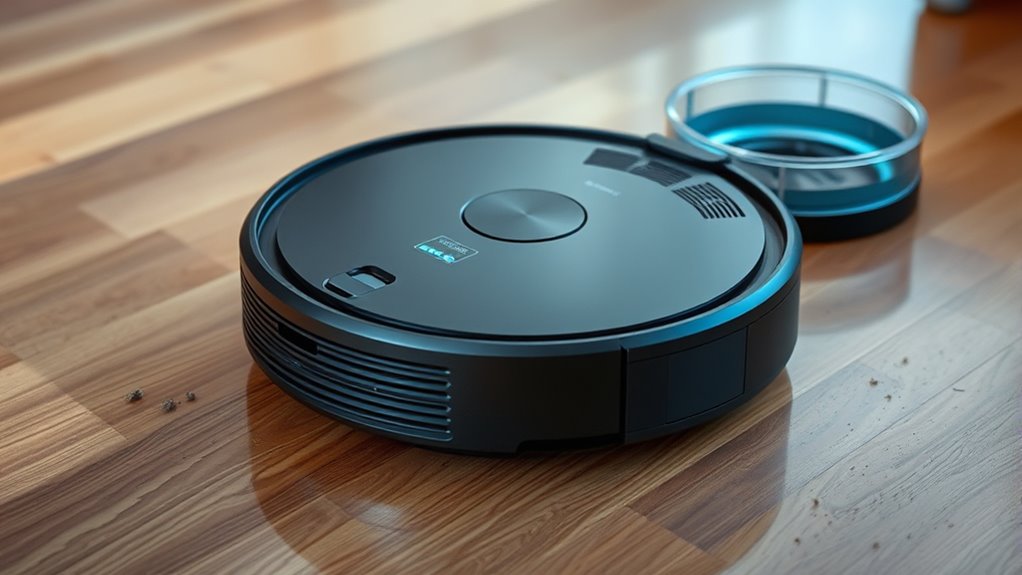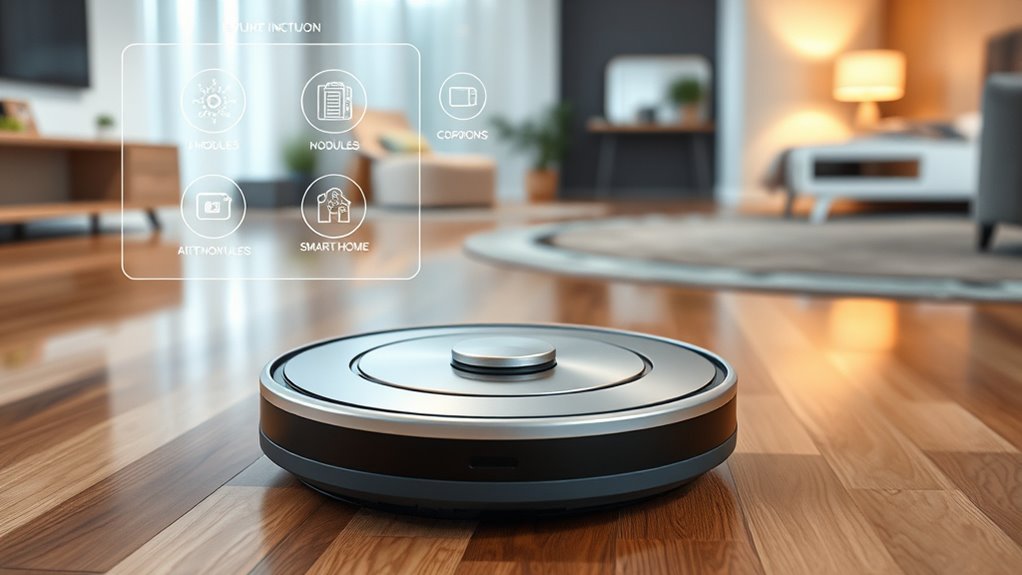Robot vacuums started as basic prototypes in the 1950s, mainly controlling simple movements. Over time, innovations like sensors, lidar, and cameras transformed them into smart devices capable of mapping your home and avoiding obstacles. Today’s models feature automatic dirt disposal, app control, and advanced navigation, making cleaning effortless. As technology keeps evolving, there’s plenty more to discover about how these intelligent cleaners continue to improve your home.
Key Takeaways
- Early prototypes in the 1950s laid the foundation for autonomous cleaning but lacked practical features.
- Technological advances like sensors, lidar, and visual mapping from the 1990s onward improved navigation and reliability.
- Modern robot vacuums incorporate AI, smartphone control, and features such as zone cleaning and self-emptying stations.
- Continuous innovations in obstacle avoidance, multi-room mapping, and automation have enhanced efficiency and safety.
- Cost reductions and advanced sensor integration have made sophisticated robot vacuums widely accessible to consumers.
Early Concepts and Prototypes

The development of robot vacuums began with early experiments and prototypes that set the stage for future innovations. In 1956, Donald G. Moore filed a patent for a robot floor cleaner that looked like modern robot vacuums and was controlled by a single button following a pre-programmed path. His early prototypes aimed to vacuum and mop floors, a feature only realized in recent models. During the late 1950s, companies like RCA-Whirlpool showcased robotic cleaning devices, such as a mockup at the Miracle Kitchen display in Moscow, demonstrating initial interest in these machines. These early design concepts and prototypes laid the groundwork for technological progress, inspiring future development. Although widespread adoption took decades, these early efforts were vital in shaping the evolution of robot vacuums into the sophisticated devices we see today.
Notable Developments in Robot Vacuum History

Since the debut of the Electrolux Trilobite in 1996, notable advancements have propelled robot vacuums from simple devices to sophisticated cleaning systems. The Trilobite introduced sensors for navigation, marking a major step. In 2002, iRobot’s Roomba revolutionized the market with dirt detection and cliff sensors, making robotic vacuums more reliable and user-friendly. Dyson’s prototypes like the DC06 and 360 Eye pushed the boundaries further, though market adoption lagged. Today, robotic vacuums feature intelligent navigation with lidar, visual mapping, and even mopping capabilities. These milestones highlight rapid progress in the evolution of robot vacuums, transforming them from basic obstacle avoiders into smart, efficient cleaning systems. Advanced mapping technology now enables precise room coverage and customized cleaning routes, further enhancing their effectiveness.
Technological Milestones in Robotics Cleaning

Technological milestones have transformed robotic cleaning from basic obstacle avoidance to highly sophisticated systems. LIDAR mapping, introduced with models like Neato XV-11 in 2010, enabled precise room navigation, setting the stage for smarter robots. From 2015 onward, advanced navigation systems featuring camera-based visual mapping, such as in the Roomba 980, allowed for detailed room recognition and zone cleaning. Modern vacuums now incorporate obstacle avoidance sensors, cliff detection, and dirt sensors to enhance safety and efficiency. The development of self-emptying docking stations, starting around 2018, drastically reduced manual bin emptying, increasing convenience. Additionally, the integration of navigation technology has further improved the robots’ ability to map and adapt to complex home layouts. These innovations have led to the creation of more intelligent cleaning systems that can adapt seamlessly to diverse environments, and ongoing research in AI automation promises even greater future capabilities. Moreover, advancements in sensor technology continue to push the boundaries of what robotic vacuums can achieve in home cleaning. Integrating machine learning algorithms enables these devices to improve performance over time based on their experiences.
Modern Innovations and Features

Modern robot vacuums now use advanced navigation systems like lidar, cameras, and AI to map your home accurately and avoid obstacles. You can control and monitor them easily through smartphone apps or voice assistants such as Alexa and Google Assistant. These innovations also include features like zone cleaning, automatic dirt detection, and self-emptying dustbins for effortless maintenance. Additionally, the incorporation of performance-enhancing features ensures more efficient and thorough cleaning. Incorporating battery life improvements, many models are now lightweight and compact, making them easier to handle and store when not in use. Understanding tuning laws can help manufacturers optimize these features for better performance and durability, especially when integrating sensor technology for more precise operation.
Precise Navigation Systems
Recent advancements in navigation technology have revolutionized how robot vacuums operate, making them more efficient and reliable. Modern vacuums use lidar sensors, like laser scanners, to create precise maps of your home, enabling systematic cleaning routes. Visual navigation systems, including cameras and computer vision algorithms, help them recognize obstacles and adapt their paths in real-time. Advanced sensors detect different floor types and obstacles, allowing the vacuum to adjust suction power and avoid hazards such as cables and small objects. Multi-room and multi-floor mapping capabilities enable the robot to plan thorough cleaning patterns and return to specific areas on command. Continuous improvements in navigation algorithms have increased coverage efficiency, reducing missed spots and decreasing cleaning times. Incorporating mapping technology allows for even more precise and comprehensive cleaning coverage. Additionally, innovations in sensor accuracy further enhance obstacle detection and path planning, leading to smarter cleaning performance. The integration of real-time data processing ensures the robot can adapt quickly to changes in the environment, optimizing cleaning routes dynamically. Furthermore, personalized cleaning schedules can be created based on user routines to improve convenience and efficiency. As these technologies advance, robot vacuums are becoming increasingly intelligent and adaptive, providing a seamless cleaning experience.
AI and Obstacle Avoidance
AI-powered obstacle avoidance has transformed how robot vacuums navigate your home, making their movements smarter and safer. Modern vacuums use advanced sensors like lidar, cameras, and ultrasonic devices to detect obstacles and create detailed maps of your space. With AI algorithms, they recognize static objects like furniture and movable items such as shoes or toys, avoiding collisions. Real-time data processing allows vacuums to reroute dynamically, preventing entrapment. Some models employ machine learning to adapt over time, optimizing their routes as household layouts change. Features like cliff sensors stop them from falling down stairs, while object recognition helps protect delicate items. This integration of sensors and AI ensures your vacuum cleans efficiently without manual intervention, improving safety and effectiveness. Sensors and AI work together to enhance overall cleaning performance and adapt to new environments. Additionally, advancements in navigation technology allow for more precise and efficient cleaning patterns, further elevating the capabilities of modern robot vacuums. Incorporating dynamic obstacle detection enables vacuums to respond swiftly to unexpected changes in their surroundings, maintaining high cleaning standards.
Smartphone and App Controls
You can now control your robot vacuum effortlessly through smartphone apps, giving you full command over its cleaning schedule and operations. Smartphone controls enable you to start, stop, and schedule cleaning sessions remotely, providing convenience at your fingertips. App integration offers real-time maps of the cleaning process, so you can monitor progress and see coverage areas from anywhere. Many devices support remote operation, allowing you to adjust settings on the go. Additionally, virtual assistants like Amazon Alexa and Google Assistant enhance user experience with voice commands, making hands-free control simple. Firmware updates and new features are often delivered automatically through the app, keeping your vacuum up-to-date and optimized. With these modern innovations, managing your robot vacuum has never been easier or more intuitive. Smart Capabilities also often include integration with home automation systems for seamless operation.
Advancements in Navigation and Waste Management

You’ll notice how modern robot vacuums now use precise room mapping to clean more efficiently and avoid missing spots. Automated bin emptying reduces your maintenance worries, making the process almost hands-free. Improved obstacle detection keeps the vacuum moving smoothly without getting stuck, ensuring thorough cleaning every time. Additionally, many models now incorporate advanced textile line features that allow for gentle cleaning of delicate fabrics and surfaces. These innovations also contribute to long-term durability and sustained performance, making them a smarter investment for your home.
Precise Room Mapping
Recent advancements in robot vacuum technology have markedly improved their ability to map home environments with remarkable accuracy. With precise room mapping, your vacuum can create detailed layouts using laser-based mapping and advanced sensors. This enables the device to recognize multiple rooms and floors, reducing missed spots. Enhanced navigation algorithms help avoid obstacles, prevent getting stuck, and optimize cleaning paths based on the detailed maps. You’ll notice:
- Laser-based mapping delivers highly accurate, real-time room layouts
- Navigation algorithms improve obstacle avoidance and efficiency
- Multi-room and multi-floor capabilities increase coverage
- Precise mapping ensures thorough cleaning without overlap or gaps
These innovations make your robot more intelligent, efficient, and effective at keeping your home spotless with minimal intervention.
Automated Bin Emptying
Advancements in navigation technology have made automated bin emptying a practical feature in modern robot vacuums. With precise laser LIDAR and visual mapping, these vacuums can accurately dock at their station, streamlining waste management. Self-emptying bins transfer dirt into larger, stationary containers, reducing manual maintenance and increasing convenience. The docking station typically uses a vacuum mechanism to evacuate the robot’s dustbin at the end of each cleaning cycle, allowing multiple sessions without user intervention. Although this automation was once costly, it’s now accessible in many midrange and premium models. These innovations enhance overall cleaning efficiency, minimize user effort, and ensure that your vacuum can operate seamlessly for extended periods, making automated bin emptying an essential feature in the evolution of robot vacuums.
Obstacle Detection Systems
As robot vacuums have become more sophisticated in managing waste, their navigation systems have also seen significant improvements. Advanced sensors, like lidar and cameras, enable precise obstacle detection and mapping capabilities, making autonomous cleaning more efficient. These systems help vacuums recognize and avoid objects such as shoes, cables, and toys, reducing damage and entrapment. Key advancements include:
- Enhanced obstacle detection for better navigation
- Accurate room mapping with lidar technology
- Real-time obstacle recognition systems
- Improved waste management integration
Together, these features ensure your robot vacuum navigates smoothly, cleans thoroughly, and minimizes accidents. The evolution of obstacle detection systems has truly transformed autonomous cleaning, making it smarter, safer, and more reliable for everyday use.
Future Trends and Predictions in Robot Vacuum Technology

Future trends in robot vacuum technology point toward smarter, more adaptable devices that can seamlessly integrate into your smart home. Artificial Intelligence and machine learning advancements will let your robot vacuum dynamically adjust to household changes, optimizing cleaning routines and schedules. Expect longer battery life, potentially exceeding two hours, allowing for more thorough cleaning sessions. Enhanced sensor technologies will improve obstacle avoidance, helping vacuums recognize different floor types and environmental conditions—reducing damage and boosting efficiency. Integration with your smart home ecosystem will enable voice control, automation, and personalized cleaning plans. Emerging innovations may also see robotic vacuums serving dual purposes, like security surveillance and environmental monitoring, alongside cleaning. These advancements will make your robot vacuum smarter, more efficient, and more versatile than ever before.
Frequently Asked Questions
What Is the History of Robotic Vacuums?
You wonder about the history of robotic vacuums. It started in the 1950s when Donald G. Moore filed a patent for a robot floor cleaner. In 1996, Electrolux launched the Trilobite, using sensors but with limited efficiency. Then, in 2002, iRobot introduced the Roomba, which became popular due to better navigation. Since then, advancements like mapping and app control have transformed these devices into the smart cleaners you use today.
How Has the Vacuum Cleaner Evolved?
You see, vacuum cleaners have come a long way. You’ve gone from heavy, corded models to lightweight, cordless ones with powerful suction. Early robotic prototypes in the 50s and 60s set the stage, and now, with sensors and smart tech, your vacuum can navigate, adapt to surfaces, and even connect via Wi-Fi. Today, you get versatile, automated cleaning devices that make your life easier and more efficient.
Have Robot Vacuums Improved?
You might wonder if robot vacuums have truly improved, and the answer is a definite yes. While they used to be basic cleaners, today’s models use advanced navigation, AI, and smart features that make them more reliable and efficient. You’ll find self-emptying bins, mopping functions, and remote control options that fit seamlessly into your busy life, offering convenience and smarter cleaning than ever before.
What Is the First Generation Robot Vacuum?
The first generation robot vacuum, like the Electrolux Trilobite from 1996, was your early attempt at autonomous cleaning. You’d find basic bumper sensors and simple obstacle detection guiding it around your home. These models had limited mapping, often getting stuck or missing spots, and relied on infrared or ultrasonic sensors. Despite their limitations, they proved that autonomous home cleaning was possible, paving the way for more advanced models.
Conclusion
As you explore the evolution of robot vacuums, you’ll see how they’ve transformed cleaning habits worldwide. Did you know that the global robot vacuum market is expected to reach $5 billion by 2027? With continuous innovations in navigation, AI, and waste management, these devices will only get smarter and more efficient. Embrace the future of effortless cleaning, and stay excited about the incredible breakthroughs still ahead in this rapidly advancing technology.







